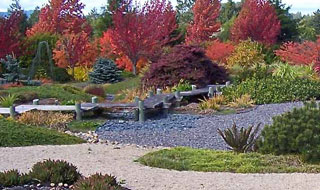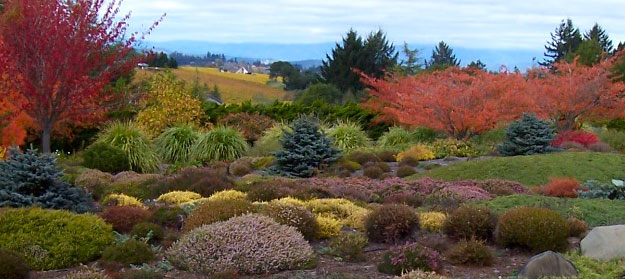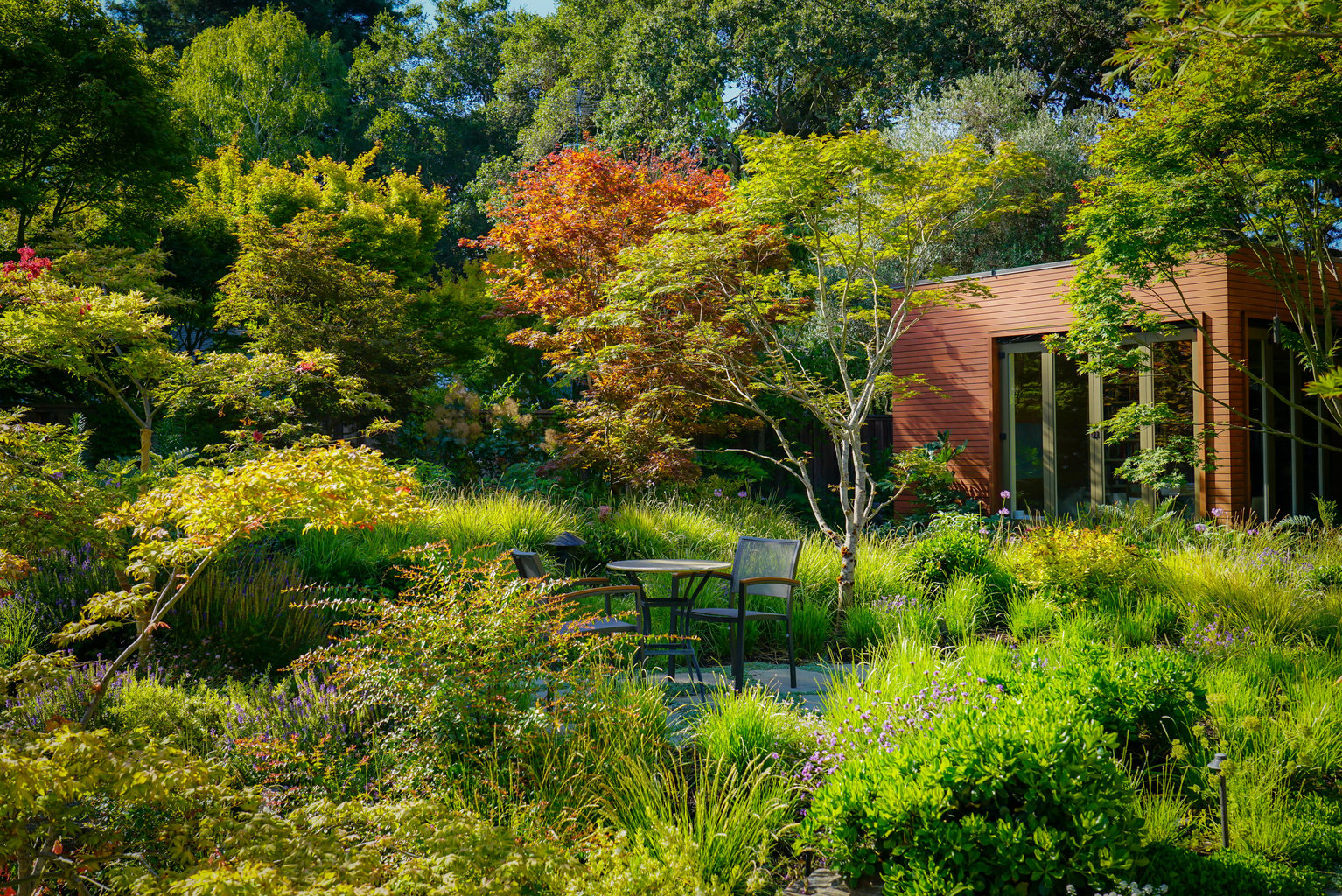

Contributor
- Topics: Archive

I was astonished. Tucked away in the coastal hills west of Sebastopol, only a few miles from my home, this jewel of a garden had been hiding for years; I had found treasure.
The owner and designer of the garden, Noriko Hasegawa, is a professional watercolorist who brings an artist’s eye to the creation of this botanical masterpiece imbuing the landscape with the clear, luminous color and graceful composition of her paintings. “It is much harder to ‘paint’ a garden and a lot more work,” she confesses, graciously making light of the obvious: namely, that this garden was a huge undertaking.

Sliding glass doors in the living room frame the view of an expanse of woody plants, boulders, and gravel, the largest and most outstanding of the landscaped plantings surrounding the home. Unfolding over an acre at the back of the house, with vistas to the north and the east, the garden is perfectly serene and complete. I found myself irresistibly drawn to cross the wooden deck and walk around the landscape. Like a classic Japanese strolling garden, the garden beckons exploration and slow thoughtful wandering to allow plenty of time to take in all the details.
Noriko and her late husband, Jun, bought the property in 1986. The land, which had once been used for pasturing horses, had distant views of Sebastopol and Santa Rosa and reminded her of the place where she grew up in Japan. Her husband urged her to create a garden, and particularly wanted it to be in the traditional style called Shinji-ike, a pond garden with an island and bridges. The local soil was too sandy and porous to support a real pond, so Noriko opted for a dry pond and made skillful use of gravel, stone, and plantings to suggest water—an approach that proved to be more drought-tolerant and easier to maintain than a real water garden would have been.
This fresh reinterpretation of traditional Japanese garden design shaped the creation of the entire garden, allowing it to reflect a stable balance of old and new. Japanese cedar (Cryptomeria japonica) and coast redwood (Sequoia sempervirens) were planted to shelter the house and garden. The careful placement of the trees was largely dictated by Noriko’s desire to edit the view, an important facet of a technique known as shakkei, or “borrowed scenery.” Distant views of the surrounding landscape are echoed in the shapes, textures, and colors of plantings, creating a boundless feel to the garden even while retaining its intimacy.

The shallow bowl of the dry pond was scooped out by a small bulldozer and surplus soil was shaped into an island. A yatsuhashi-style plank bridge, with its traditional eight zig-zags, was constructed along the edge of the pond nearest the house. A seemingly perverse motif, the design of the bridge slows one’s crossing and provides the opportunity to “stop and smell the roses.” Here, one is not offered roses to appreciate, but Japanese iris (Iris ensata), which can be viewed up close even while keeping one’s feet dry.
Stonework in the pond represents another break with tradition. Rough, moss-covered rocks are more typical of Japanese gardens but Noriko, at the suggestion of her contractor, Richard Flaxco, determined that moss-covered rocks would appear out of place in the dry, full-sun exposure. Smooth-surfaced beach rocks with subtle colorations mark the places where water would flow in and out of the pond and larger, more elongated stones are set to suggest rapids. The stones suit the
design handsomely.
Plantings around the pond are an engaging mixture of traditional and nontraditional choices. Initially, 20 flowering cherries (Prunus) were planted to frame the garden including a mix of older varieties like ‘Akebono’, ‘Kwanzan’, and ‘Shirotae’,
and newer varieties like ‘Pink Cloud’ and the purple-leafed ‘Royal Burgundy’. Of the original plants, four were lost to either drought or gophers, but the survivors have flourished and achieved an impressive size, offering the classic beauty of spring flowers and warm, glowing foliage color in the fall.
Japanese maples (Acer palmatum), mostly dwarf and lace-leafed varieties, were used sparingly in the landscape with varieties selected to tolerate full sun and drier soil. Burning bush (Euonymus alatus), while not popular in California, was very familiar to Noriko both from Japan and from her first American garden in upstate New York. Trained as small, rounded trees, burning bush forms a low backdrop on the north side of the pond where they thrive and reliably contribute their distinctive deep salmon-pink fall color to the brilliance of the maples and a grove of liquidambars (Liquidambar styraciflua).
Dwarf conifers, including dwarf blue spruce (Picea), dwarf Japanese cedars (Cryptomeria) and mugo pine (Pinus mugo) were used as specimens throughout the landscape. Japanese garden juniper (Juniperus procumbens) carpets mounded plantings to tie the design together.
A wide variety of heaths and heathers (Erica and Calluna) were decidedly offbeat choices for Noriko’s garden, but they have also thrived, seasonally providing low mounds of rich color with their flowers and foliage. She was especially pleased to discover that gophers don’t bother them. Experimenting with blending hardy aloe (Aloe mitriformis) with other groundcovers has proven successful. Although, Noriko admits, the drought-tolerant plants do stand out rather blatantly when they produce their bright orange flowers in early summer.

Unusual plants with bold clumps of narrow strap-like foliage, skillfully grouped around the back edges of the pond, caught my eye. Glossy, yellowish-green leaves suggested the presence of water in the way that cattails (Typha) would, but these plants had a strong weeping habit completely different from the upright foliage of the water plant. I was delighted to find these were well-grown specimens of Lomandra longifolia, an evergreen, grasslike plant from Australia. Years ago, Noriko received a gallon-size container of lomandra, a large form which is still rare in Northern California gardens, from a friend. Numerous divisions of the original plant made over the years have thrived and today are outstanding accents in this most unusual garden.
Indeed, if Noriko’s garden has a spirit—and it does, as surely as any personal garden must—then the lomandra is one of many special plants that embody that spirit. This spirit is experienced as the sense of being in an ideal place, a garden of exotic elements, harmoniously blended to both soothe and stimulate the soul of the viewer. Just as in a painting.
Share:
Social Media
Garden Futurist Podcast
Most Popular
Videos
Topics
Related Posts

Low Maintenance Gardens – Better for Pollinators and People
Autumn 2022 “I come out every day. It’s therapy, my meditation.” Janet’s young garden transformed from overgrown, invasive plants to mostly natives. The dailiness of

Invasive Plants Are Still Being Sold: Preventing Noxious Weeds in Your Landscape
Autumn 2022 With so many beautiful ornamental plant species and cultivars throughout California and the Pacific Northwest, how do you decide which ones to include

Garden Design in Steppe with Transforming Landscapes with Garden Futurist Emmanuel Didier
Summer 2022 Listen to full Garden Futurist: Episode XVII podcast here. Emmanuel Didier, Principal and Creative Director at Didier Design Studio is a leading figure

Seslerias: Versatile Groundcover Meadow Grasses
Summer 2022 Without question, the most beautiful and versatile of all the groundcover meadow grasses are the moor grasses (Sesleria). Moor grasses tick off all









Responses